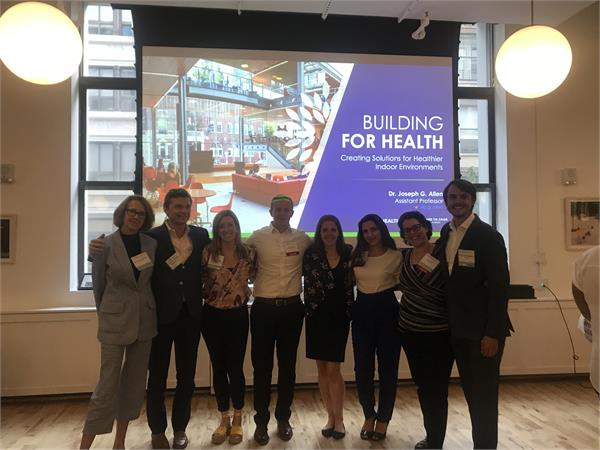Employee Productivity: Explaining and Quantifying the Impact of Indoor Air Quality
July 2019

On Monday evening, July 15, CoreNet’s Sustainability Committee hosted Dr. Joseph Allen, Director of the Healthy Buildings Program, T.H. Chan School of Public Health, Harvard University. The event was hosted at WeWork’s headquarters at 115, 18th Street.
Dr. Allen was introduced by John Mandyck, the Chief Executive Officer of the Urban Green Council. Mr. Mandyck provided an insightful segway to the lecture topic with an overview of Local Law 97, a new piece of legislature that will require all buildings in New York City 25,000 square feet and greater to limit the amount of fossil fuels used by as much as 40% by 2030. Burning fossil fuels releases carbon dioxide and contributes to climate change. This process also releases a number of toxins including particulate matter, ozone and sulfates into the air which compromise our immune systems leading to a number of diseases including cancer, heart disease and asthma.
The effect of these toxins on indoor air and people is the focus of Dr. Allen’s work. He reminded us that 90% of our lives are spent indoors. Green movements have done a great job of telling us how to make the outdoor environment healthier, but often at the expense of indoor air quality despite them working best hand in hand.
Dr. Allen’s work on those of us who live indoors, “the indoor generation” is riveting. He explained that current laws governing air quality including ASHRAE and OSHA have not set the bar high enough and consequently buildings are not providing the amount of ventilation, or fresh air from outside, to help us stay healthy and maximize cognitive function.
Dr. Allen tested this theory in his COGfx studies which enrolled a group of professionals or “knowledge workers” in a 2-week study. The study varied the way air was brought into their workspace, ranging from what today is considered the “acceptable indoor air” standard, and one that optimized the air by doubling the amount of fresh air brought in. In addition, in the optimal scenario, toxins such as VOC’s (volatile organic compounds) were reduced by controlling the products that emit these chemicals including cleaning materials, types of clothing and building materials. All other factors – lighting, acoustics – were held constant. At the end of the day standardized tests were given to test cognitive function.
The results showed that breathing better air provided “significantly better decision-making performance” on average over 60% higher performance. Most interesting was the fact that exercises testing how strategic decisions were made in crises showed the biggest improvement in optimal environments. Dr. Allen did similar tests on pilots in simulated aircraft carriers and the results are sobering.
So why aren’t we doing this?
There is a misconception, Dr. Allen explained, that the cost of providing better air is cost prohibitive. The facts prove differently: doubling the amount of fresh air to an occupant will cost approximately $40/person/year. The reduction in absenteeism and greater productivity by doing this clearly outweighs this cost.
Dr. Allen concluded his lecture by telling us about new research done with a team of experts from related fields. The result, “The 9 Foundations of a Healthy Building”, present 9 principles that make for an optimal indoor environment, focusing on commercial office space. The study was born out of the realization that great research was out in the world advocating for better indoor environments but was often not readable and therefore couldn’t be used to effectively advocate for change.
I’ve read the study and find that each of the 9 principles is supported by a succinct, eloquent white paper that is an easy read, providing accessibility to complicated science.
We increasingly live in an environment that challenges our health, cognitive function and well-being. Dr. Allen’s work is literally and figuratively a breath of fresh air giving us all hope for a better future.
Elisabeth Post-Marner, AIA, LEED AP
Member CoreNet Sustainability Committee
*Stale Office Air is Making You Less Productive
Harvard Business Review
Joseph G. Allen
Harvard T.H. CHAN School of Public Health
The 9 Foundations of a Healthy Building 2017 Contributors
Joseph G. Allen
Ari Bernstein
Xiadong Cao
Erika Sita Eitland
Skye Flanigan
Maia Gokhale
Julie M. Goodman
Skylar Klager
Lacey Klingensmith
Jose Guillermo Cedeno Laurent
Steven W. Lockley
Piers Macnaughton
Sepideh Pakpour
Jack D. Spengler
Jose Vallarino
Augusta Williams
Anna Young
Jie Yin